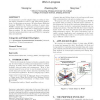DAGSTUHL
2007
14 years 28 days ago
2007
With the emergence of wireless sensor networks, the issues of event recognition and processing have been partially shifted into the embedded domain. New processing capabilities on...
FORTE
2010
14 years 28 days ago
2010
Wireless sensor networks are typically ad-hoc networks of resource-constrained nodes; in particular, the nodes are limited in power resources. It can be difficult and costly to rep...
ADHOCNOW
2010
Springer
14 years 28 days ago
2010
Springer
Random walks in wireless sensor networks can serve as fully local, very simple strategies for sink motion that reduce energy dissipation a lot but increase the latency of data coll...
INFOSCALE
2007
ACM
14 years 1 months ago
2007
ACM
It is important to provide adaptive data processing in wireless sensor networks in order to deal with various applications. In this paper,we propose a WIreless Sensor Networks Ont...
DMSN
2008
ACM
14 years 1 months ago
2008
ACM
Wireless sensor, actuator networks (WSANs) distinguish themselves from wireless sensor networks by the need to coordinate actuators' actions, real-time constraints on communi...
DCOSS
2008
Springer
14 years 1 months ago
2008
Springer
Abstract. Wireless sensor networks come of age and start moving out of the laboratory into the field. As the number of deployments is increasing the need for an efficient and relia...
DCOSS
2008
Springer
14 years 1 months ago
2008
Springer
This paper introduces a framework for in-field-maintenance services for wireless sensor networks. The motivation of this work is driven by an observation that many applications usi...
GLOBECOM
2007
IEEE
14 years 1 months ago
2007
IEEE
- How to prolong the lifetime of wireless sensor networks is one of the most important design issues. In order to tackle this issue, we propose an energy-efficient polynomial regre...
CISS
2007
IEEE
14 years 1 months ago
2007
IEEE
– The process control industry has shown great interest in implementation of low cost, low power wireless sensor networks. Such networks are much easier to deploy and reconfigure...
DSN
2005
IEEE
14 years 1 months ago
2005
IEEE
The behavior of large-scale wireless sensor networks has been shown to be surprisingly complex and difficult to analyze, both by empirical experiment and simulation. In this pape...


